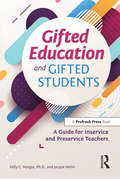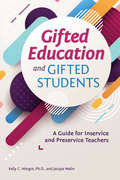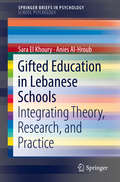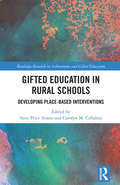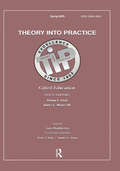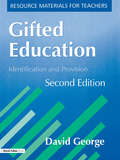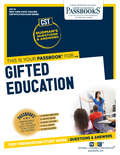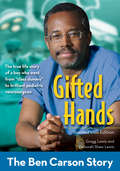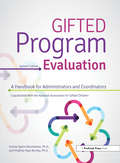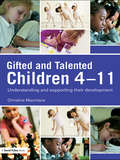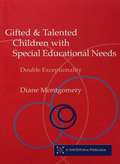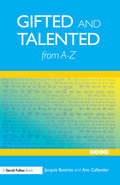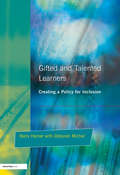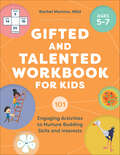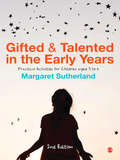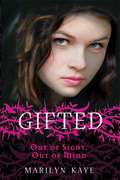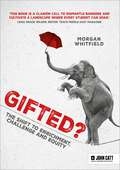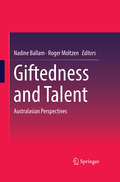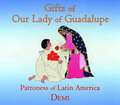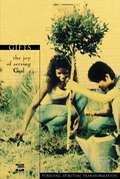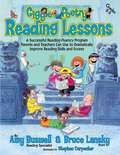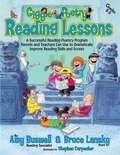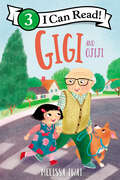- Table View
- List View
Gifted Education and Gifted Students: A Guide for Inservice and Preservice Teachers
by Kelly Margot Jacque MelinAlthough most teacher education programs offer classes on special education and English language learners, teachers often do not receive any training in the needs of high-ability students or gifted education practices. This book:
Gifted Education and Gifted Students: A Guide for Inservice and Preservice Teachers
by Kelly MargotAlthough most teacher education programs offer classes on special education and English language learners, teachers often do not receive any training in the needs of high-ability students or gifted education practices. This book:Prepares inservice and preservice teachers to educate high-ability students.Addresses learning targets through a combination of research and practical strategies.Includes a selection of activities to check for teacher understanding.Is concise and user-friendly.Is perfect for both individual and collaborative learning. Each chapter opens with a driving question and a list of learning targets related to various topics, including key philosophies, theories, and models; educational factors that enhance or inhibit talent development; characteristics of advanced learners; and the role of culture, ethnicity, and language in the identification process.
Gifted Education in Lebanese Schools: Integrating Theory, Research, And Practice (SpringerBriefs in Psychology)
by Anies Al-Hroub Sara El KhouryThis Brief discusses research about gifted education in Lebanese schools. It provides an overview of the latest theories, definitions, and practices used to identify gifted students in Lebanese schools. Chapters begin by providing background information on the status of gifted education in Lebanon and the challenges gifted Lebanese children face. Subsequent chapters discuss recent and relevant international definitions of giftedness as well as common misconceptions and underrepresentation of giftedness. The Brief presents research study findings on the cultural definition of giftedness in the minds of Lebanese teachers. It also presents findings on current practices used to identify gifted learners in Lebanese schools. It concludes with recommendations from the teachers that participated in the reported study as well as the authors’ proposal for a Lebanese elementary school policy for identification of gifted students. Gifted Education in Lebanese Schools is an informative resource for researchers, professionals, practitioners, and graduate students in the field of school psychology, educational psychology, gifted and special education, and social work.
Gifted Education in Rural Schools: Developing Place-Based Interventions (Routledge Research in Achievement and Gifted Education)
by Carolyn M. Callahan Amy Price AzanoThis text draws on data from a five-year longitudinal study focusing on gifted education programs in high poverty rural areas in the US. It provides a framework for the use of place-based interventions to effectively serve gifted students, reduce opportunity gaps, and address stereotype threat. Recognizing that gifted learners are often underrepresented in rural contexts, the text adopts a social justice lens to outline the unique challenges of fostering advanced education in rural school districts. Using opportunities to learn and best practices in gifted education to inform interventions and practice, the text offers in-depth explanation of how place-based approaches can be used to identify gifted students and ensure that curricula are designed to respect the setting, students, and teachers. The text is structured into three parts, providing the reader with a logical and comprehensive progression through theoretical foundations, the practicalities of implementation, and the process and outcomes of measuring and validating outcomes. Given its unique approach to gifted education programs, this book will prove to be an indispensable and timely resource for scholars working to develop gifted education and educational interventions with and for rural schools.
Gifted Education: A Special Issue of Theory Into Practice
by Peter V. Paul Robert Lawson Anita Woolfolk Hoy Sandra A. Stroot Donna B. EvansA scholar's dream come true, 40 years of The Ohio State University's educational journal, Theory Into Practice. Every theme issue, thousands of articles, on a broad range of education-related topics, can be easily accessed. Edited and written by leading thinkers and practitioners in their fields, many of these theme issues are used in classes year after year as their message remains relevant indefinitely. Whether you are a teacher, student, professor, administrator, or librarian, Volume 44, Number 2, 2005 This Issue: Gifted Education, Applying Gifted Education Pedagogy to Total Talent Development for All Students, Gifted Programs and Services, will be of benefit to you.
Gifted Education: Identification and Provision (Resource Materials For Teachers Ser.)
by David GeorgeThis second edition provides busy teachers, other educational professsionals and parents with user-friendly text and worksheets to enable them to identify and provide provision for The author takes a multi-dimensional view of ability and believes in educating the whole child, with a curriculum of opportunity that provides high-level learning experiences. The book has been updated in view of the developments in the education of gifted and talented children, with particular attention paid to strategies for differentiation, thinking skills and subject-specific enrichment. This book is a practical companion tot he author's popular The Challenge of the Able Child. By using many photocopiable worksheets and helpful checklists, and always bearing in mind the needs of the busy practitioner, this book will useful for anyone working in this area of education. Teachers, GATCOs, teaching assistants and parents should find the information clear and the suggested strategies rooted in good practice for teaching children of all abilities.
Gifted Education: Passbooks Study Guide (New York State Teacher Certification Examination Series (NYSTCE))
by National Learning CorporationThe New York State Teacher Certification Exams (NYSTCE) are required for all candidates seeking licensure in the State. The NYSTCE series consists of many different tests assessing skills and abilities necessary for teachers. The Passbook® for the Content Specialty Test in Gifted Education provides hundreds of multiple-choice questions in the areas that will likely be covered on your upcoming certification exam, including but not limited to: characteristics of gifted students; curriculum modification; assessment and evaluation; history and philosophies of gifted education; and other related areas.
Gifted Hands, Revised Kids Edition: The Ben Carson Story
by Gregg Lewis Deborah Shaw LewisFrom Inner-City Nobody to Brilliant Neurosurgeon When Ben Carson was in school, his classmates called him the class dummy. Many—including Ben himself—doubted that he would ever amount to anything. But his mother never let him quit. She encouraged Ben to do better and reach higher for his dreams, and eventually he discovered a deep love of learning. Today this young boy from the inner-city is one of the world’s greatest pediatric neurosurgeons. Through determination and lot of hard work, Ben overcame his many obstacles and is now dedicated to saving the lives of critically ill children around the world.
Gifted Lives: What Happens when Gifted Children Grow Up
by Joan FreemanThis book reveals the dramatic stories of twenty outstandingly gifted people as they grew from early promise to maturity in Britain. Recorded over the last thirty-five years by award-winning psychologist, Joan Freeman, these fascinating accounts reveal the frustrations and triumphs of her participants, and investigates why some fell by the wayside whilst others reached fame and fortune. These exceptional people possess a range of intellectual, social and emotional gifts in fields such as mathematics, the arts, music and spirituality. Through their particular abilities, they were often confronted with extra emotional challenges, such as over-anxious and pushy parents, teacher put-downs, social trip-wires, boredom and bullying in school and conflicting life choices. Their stories illustrate how seemingly innocuous events could have devastating life-long consequences, and confront the reader with intriguing questions such as: Does having a brilliant mind help when you are ethnically different or suffering serious depression? How does a world-class pianist cope when repetitive strain injury strikes, or a young financier when he hits his first million? What is the emotional impact of grade-skipping? Joan Freeman’s insights into the twists and turns of these lives are fascinating and deeply moving. She shows us that while fate has a part to play, so does a personal outlook which can see and grab a fleeting chance, overcome great odds, and put in the necessary hard work to lift childhood prodigy to greatness. Readers will identify with many of the intriguing aspects of these people’s lives, and perhaps learn something about themselves too.
Gifted Program Evaluation: A Handbook for Administrators and Coordinators
by Kristie Speirs Neumeister Virginia Hays BurneyFaced with budget challenges, many districts cannot afford to hire an outside consultant to conduct a formal evaluation of their gifted programs. Districts may wish to conduct their own in-house program evaluation. The second edition of Gifted Program Evaluation: A Handbook for Administrators and Coordinators is designed to assist administrators in designing, conducting, and reporting on an evaluation of their gifted programs. Written with the busy administrator in mind, this handbook includes an overview of evaluating programs to ensure that (1) the program structure is based on best practice, (2) students are achieving at levels commensurate with their abilities, and (3) the program develops skills that gifted students will need to be meaningful contributors in society, including higher level thinking, communication, and affective skills. The book provides all of the tools to assist evaluators, including an in-depth description of how to conduct a program evaluation, the mechanics of collecting and analyzing a variety of different data sources, and how to organize, write, and share the findings. It also features reproducibles, including interview and survey question banks, classroom observation tools, professional development forms, and program element checklists.
Gifted and Talented Children 4-11: Understanding and Supporting their Development
by Christine MacIntyreCan you recognize and tell the difference between gifted and talented children? Do you know how to provide the support they need? Responding directly to current thinking in education, this book raises practitioners’ expectations, and shows you how to identify children in your class as gifted and talented. Christine Macintyre addresses the nature/nurture debate in relation to gifted and talented children, and discusses related topics such as the norms of development and domains of learning. Essential reading for all primary teachers and teaching assistants, this fascinating book is full of practical suggestions enabling you to: recognise the innate nature of giftedness provide the teaching required for talent to emerge understand the experiences of gifted and talented children develop activities to challenge and encourage your gifted and talented children to widen their repertoire of skills and abilities A chapter on neurological development is included to confront questions such as "what is it that enables children to do well", and even "Is there a gene for genius?" Contrasting and conflicting answers are shared and debated. Finally, the issue of gifted and talented children with a learning difference/disability is raised and examples are given of how this ASD (asynchronous development) can hinder the recognition of gifts and talents in these children.
Gifted and Talented Children with Special Educational Needs: Double Exceptionality (A\nace/fulton Publication Ser.)
by Diane MontgomeryGifted pupils who also have special needs often receive provision for the special need whilst the giftedness is overlooked. Children with such double exceptionality can become depressed, frustrated and misbehave, and may not fulfil their potential. Based on international research and practice, this practical text enables the reader to identify highly able pupils with special needs, such as ADHD, dyspraxia, dyslexia and Downs Syndrome, and then make provision for them within the mainstream school. The book offers three emerging themes: creating a positive, constructive and supportive learning environment; offering a cognitively challenging curriculum; and engaging the learners in partnership to understand and manage their learning support. Whilst aimed mainly at teachers and students at both primary and secondary levels, this book should also be of interest to educators, researchers and educational psychologists.
Gifted and Talented Education from A-Z (nasen spotlight)
by Buttriss CallanderThis quick reference guide contains comprehensive listings and definitions of common terms in able, gifted and talented education, as well as other aspects that you might need to learn about, find or use – all in a teacher-friendly format. It includes: clear and concise definitions that translate jargon into plain English a 'who's who' guide of gifted and talented education explaining the contribution of major experts and theorists alphabetical listings of organisations, resources, suppliers and websites full cross-referencing so you can find your answers quickly.
Gifted and Talented Learners: Creating a Policy for Inclusion (A\nace/fulton Publication Ser.)
by Deborah Michel Barry HymerThis book sets out the educational challenges, benefits and possibilities of embracing a truly inclusive approach to gifted and talented education and provides a framework for a school to create its own inclusive policy in this area of need. Calling on international research, current educational initiatives, and work within the Barrow Education Action Zone (EAZ) and elsewhere, the authors set out to demonstrate that the inclusion and standards agendas can - and should - take with them the growing interest in the educational needs of gifted and talented pupils. The result is a short but comprehensive and fundamentally practical book, which will be of value to any school or LEA wishing to create and implement a dynamic, reflective and inclusive policy for gifted and talented pupils.
Gifted and Talented Workbook for Kids: 101 Engaging Activities to Nurture Budding Skills and Interests
by Rachel MartinoHelp kids hone their skills and intelligence with fun activities for ages 5 to 7The best way for kids to learn new things and test their skills is by solving problems and answering questions on their own. This colorful summer workbook gets them started, with 101 activities that are modeled after Gifted and Talented education programming. Each one is designed to engage kids and boost their academic ability, with exercises that cover everything from solving math problems and spotting patterns to critical thinking and writing.This workbook is an excellent summer bridge learning tool, keeping your child's mind active during the vacation. Its exercises ensure a smooth transition from kindergarten to 1st grade.Develop young minds—With a wide range of activities, kids will practice their test skills and explore topics like language, science, and art.Tips for parents—Each exercise includes a brief note to explain the different skills it teaches, so parents and caregivers know exactly what kids are learning.Next steps—Learn about Gifted and Talented programming and find out how this book can help kids prepare for placement assessments in the future.Give kids the tools to explore their skills and gain academic confidence with the Gifted and Talented Workbook for Kids.
Gifted and Talented in the Early Years: Practical Activities for Children aged 3 to 6
by Margaret Sutherland′This new edition advocates an inclusive approach and updates current theories, research and best practices in the field. The text incorporates 21st century skills, cultural perspectives and international education, and focuses on how to create appropriately challenging activities for the young gifted and talented child′Gillian Eriksson, Coordinator: Gifted Education Program, School of Teaching, Learning and Leadership, University of Central Florida ′This expanded edition builds on Margaret′s approach to teaching and learning, making us think how we can best include gifted and talented children in our early years settings. By providing opportunities for young children to learn from each other and from their communities and families, gifted and talented young learners can be appropriately challenged and recognised within an inclusive setting′ -Peter Merrotsy, Senior Lecturer in Gifted and Talented Education, University of New England, Australia Combining theoretical perspectives with practical activities, this book offers clear guidance on how to ensure you and your setting can identify and provide for very young children in your care who are gifted and talented. With an emphasis on providing the best learning opportunities for all, there is specialist advice for all staff working in early years settings. New to this new edition is: - information on recent research and new thinking in the field - international views of gifted and talented young children - links to the early years curriculum - new activities and ideas - extended coverage for young children aged 3 to 6 There are lots of ideas for things to try out in your setting, and photocopiable practical activities for parents to try out at home. Margaret Sutherland is a Lecturer in Additional Support Needs at the University of Glasgow and Director of the Scottish Network for Able Pupils (SNAP).
Gifted: Out of Sight, Out of Mind
by Marilyn KayeQueen of Mean Amanda Beeson is shocked to find herself in the body of one of her victims, Tracey Devon, who has the ability to become invisible. It soon becomes clear to Amanda that at Meadowbrook Middle School, the definition of "gifted" has a whole other meaning.
Gifted?: The shift to enrichment, challenge and equity
by Morgan Whitfield'Gifted and talented' is a zombie. It is dead, but still walking around. There are new labels to stratify students - 'more able', 'significantly able', 'high-aptitude learners'. New labels do not equal new thinking. The concept of 'gifted' is still stubbornly embedded in our educational structures, with its legacy of social immobility, racism and sexism. Students can be 'more able' when they have more financial resources, more access, more visibility, or more cultural acceptance. There are pervasive narratives that educators should prioritise extension for some students and not others. We can dispel the myth that pitching lessons judiciously to 'middle ability', and then differentiating up and down, is effective.This book explores how we can provide every student with rigorous challenge. Challenge for all is an inclusive approach to teaching, whereby every student is invited, and given the tools, to reach a place of mastery. This can be through project-based learning, Harkness round-tables, oracy, adaptive teaching, inclusive enrichment programs, dynamic classroom strategies and a schoolwide mission for equity. Educators can embed powerful knowledge into the curriculum, reimagine teaching to the top, and stretch learners through personalised and responsive instruction. The shift to enrichment, challenge and equity creates magnificent possibilities. The message to all students is: you belong here.
Gifted?: The shift to enrichment, challenge and equity
by Morgan Whitfield'Gifted and talented' is a zombie. It is dead, but still walking around. There are new labels to stratify students - 'more able', 'significantly able', 'high-aptitude learners'. New labels do not equal new thinking. The concept of 'gifted' is still stubbornly embedded in our educational structures, with its legacy of social immobility, racism and sexism. Students can be 'more able' when they have more financial resources, more access, more visibility, or more cultural acceptance. There are pervasive narratives that educators should prioritise extension for some students and not others. We can dispel the myth that pitching lessons judiciously to 'middle ability', and then differentiating up and down, is effective.This book explores how we can provide every student with rigorous challenge. Challenge for all is an inclusive approach to teaching, whereby every student is invited, and given the tools, to reach a place of mastery. This can be through project-based learning, Harkness round-tables, oracy, adaptive teaching, inclusive enrichment programs, dynamic classroom strategies and a schoolwide mission for equity. Educators can embed powerful knowledge into the curriculum, reimagine teaching to the top, and stretch learners through personalised and responsive instruction. The shift to enrichment, challenge and equity creates magnificent possibilities. The message to all students is: you belong here.
Giftedness and Talent
by Nadine Ballam Roger MoltzenThis book brings together recent postgraduate research in the broad area of giftedness, talent development and gifted education conducted across New Zealand and Australia. It addresses the significant demand for research in the field undertaken outside the United States and offers valuable practical insights. Divided into 14 chapters, the book explores giftedness and talent in a diverse range of socioeconomic cohorts and contexts, including examinations of gender, race and ethnicity. Though primarily intended for practitioners, it will also benefit undergraduate and postgraduate students, researchers and educators in New Zealand, Australia and beyond.
Gifts of Our Lady of Guadalupe: Patroness of Latin America
by DemiJust before dawn on Saturday the 9th of December, 1531, Juan Diego was on his way to Mass near Mexico City. He came to a hill known as Tepeyac just as day broke. He could hear the singing of many beautiful birds, but then the singing suddenly stopped. As he looked towards the top of the hill he heard someone calling his name. He was amazed to see a beautiful lady. Her clothes glimmered like the sun and her brilliance made the rocks and plants sparkle like jewels. Juan Diego bowed deeply before her, as she told him that she was Holy Mary, the Mother of God. Then she instructed him to go to the bishop in Mexico City and ask him to build a great church so that people would come to know her love, compassion, and protection. But the bishop wished for a sign. In this beautiful retelling of the story by award-winning author, Demi, find out how the miracles performed by the Virgin of Guadalupe persuaded the bishop to build the church; how they caused ten million Aztecs to convert to Catholicism within just eight years; and why the basilica dedicated to the Virgin of Guadalupe today receives 20 million pilgrims per year, making it the most popular Christian pilgrimage site in the world.
Gifts: The Joy of Serving God (Pursuing Spiritual Transformation)
by John Ortberg Laurie Pederson Judson PolingGifted--that’s you! Uniquely equipped to help build up the body of Christ. As a follower of Jesus, serving others is an integral part of your identity and an important key to your personal growth. But how do you cultivate a servant’s heart and your spiritual gifts in ways that build up your church, your family, your friends, and your world--without wiping you out in the process? Gifts guides you to the answers. Through personal study and small group interaction, this study will help you develop a passion to be used by God. You’ll find out about your unique place in the body of Christ and how to surmount the obstacles that keep you from thriving. You’ll discover the joy of serving with others--doing together what you cannot do alone. And you’ll learn how to abide in Christ, experiencing a freshness and vitality that grow as you give!Leader’s guide included!Gifts group sessions are:Use Me!Use My Gifts!Walking into WeaknessComparison: The Killjoy of ServanthoodThe Ministry of the MundaneServanthood’s Bell-Shaped CurveAbide in Him
Giggle Poetry Reading Lessons Sample: A Successful Reading-Fluency Program Parents and Teachers Can Use to Dramatically Improve Reading Skills and Scores
by Bruce Lansky Stephen Carpenter Amy BuswellSample Lesson from Amy Buswell and Bruce Lansky's Giggle Poetry Reading Lessons! Turn struggling readers into happy readers — For Grades 2–5.This sample lesson and introduction from Giggle Poetry Reading Lessons provides the research and methodology behind the most entertaining fluency intervention ever! As well as a kid-tested poem, customized reading lesson, an off-the-wall illustration, and zany performance tips—all designed to make the process of reading more like fun than work! Perfect for teachers and parents who want to help children improve their reading. Check out the full version of Giggle Poetry Reading Lessons available in softcover and eBook for the full lesson plan.
Giggle Poetry Reading Lessons: A Successful Reading-Fluency Program Parents and Teachers Can Use to Dramatically Improve Reading Skills and Scores
by Bruce Lansky Stephen Carpenter Amy BuswellHow Giggle Poetry Reading Lessons Turn Struggling Readers into Happy Readers -- For Grades 2-5.Many struggling readers are embarrassed to read aloud. They are often intimidated or bored by texts that conventional programs require them to practice. So, instead of catching up, they fall further behind. Currently 67% of American fourth graders can't read grade-level text. Reading specialist Amy Buswell has spent eight years looking for remediation methods that work. "What is needed," Buswell explains, "is a program that improves the motivation of struggling readers, because that accounts for 90% of the problem." Four years ago, Buswell came up with a brainstorm. She knew her best readers enjoyed reading Bruce Lansky's poetry books for pleasure. The more poems they read, the better their reading got. Why not use Lansky's kid-tested poems as texts struggling readers could practice on to improve their reading--using six research-based strategies: choral reading, echo reading, paired reading, repeated reading, sustained silent reading and "say it like the character" reading. -- This book is the result of that brainstorm and the resulting collaboration between Buswell and Lansky. It gives teachers and parents everything they need to help children improve their reading: -35 kid-tested poems by Bruce Lansky -35 customized reading lessons by Amy Buswell -35 off-the-wall illustrations by Stephen Carpenter -35 sets of zany performance tips by Bruce Lansky ...all of which is designed to make the process of reading improvement more like fun than work. -- What Amy Buswell and Bruce Lansky have created is the most entertaining fluency intervention ever. That's why it is so successful at overcoming negative attitudes to improve reading skills and scores. Ninety-five percent of participating students made significant improvement in their fluency (reading rate). And average reading scores on the Florida Comprehensive Assessment Test (FCAT) for Buswell's school raised her school's rating to an A for the first time. In 2011, Buswell's school achieved one of the highest-percentage reading gains in the county. -- There's no reason parents can't get in on the fun, too. Parents will enjoy Lansky's funny poems and Stephen Carpenter's delightful illustrations as much as their children. By reading the poems with their children and encouraging their children to try some of Lansky's entertaining performance tips (by adding gestures, sound effects, props and finding additional readers: be they friends, family or neighbors), they can dramatically speed up their child's reading progress (and have lots of fun in the process.)
Gigi and Ojiji (I Can Read Level 3)
by Melissa IwaiGigi, a biracial six-year-old girl, learns about her Japanese culture from her grandfather when he comes to visit. Perfect for social emotional learning. <p><p>Gigi can’t wait for her Ojiji—Japanese grandpa—to move in. Gigi plans lots of things to do with him, like playing tag, reading books, and teaching Roscoe, the family dog, new tricks. But her plans don’t work out quite the way she’d hoped. And her grandpa doesn’t seem to like Roscoe. Will Gigi find a way to connect with her Ojiji? <p><p>This exciting new I Can Read series is brought to you by author-illustrator Melissa Iwai, whose popular books include Soup Day and Dumplings for Lili. Gigi and Ojiji is a Level Three I Can Read book. Level 3 includes many fun subjects kids love to read about on their own. Themes include friendship, adventure, historical fiction, and science. Level 3 books are written for early independent readers. They include some challenging words and more complex themes and stories. The story contains several Japanese words and a glossary of definitions and pronunciations.
